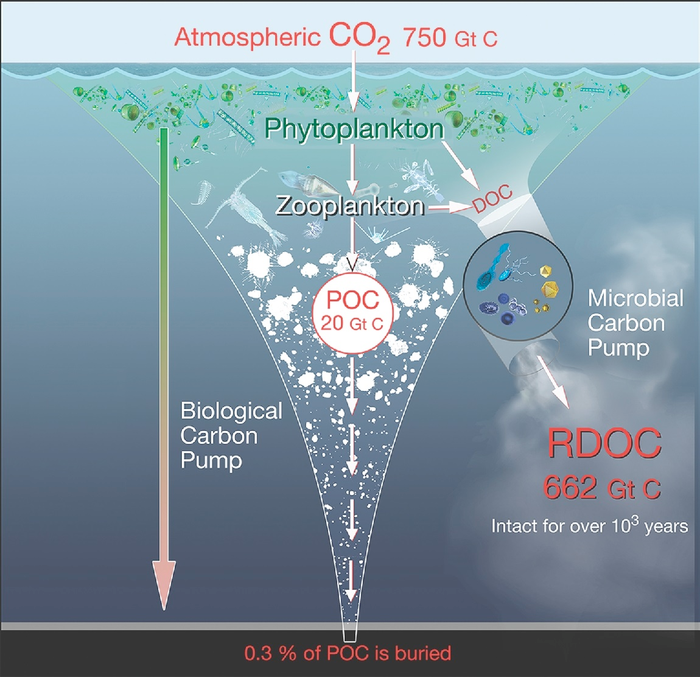As far as marine organic carbon is concerned, dissolved organic carbon (DOC) is the most common. Thus, gaining insights into its source and sink processes is of major importance to the global carbon cycle and will offer an insight into obtaining carbon neutrality.
 The BCP, which transports organic matter from the surface to the interior and floor of the ocean; the MCP, which converts parts of labile and semi-labile organic carbon (LDOC/SLDOC) into refractory DOC (RDOC) via microbial activities. Image Credit: Zhang et al., 2018, National Science Review, ©Science China Press.
The BCP, which transports organic matter from the surface to the interior and floor of the ocean; the MCP, which converts parts of labile and semi-labile organic carbon (LDOC/SLDOC) into refractory DOC (RDOC) via microbial activities. Image Credit: Zhang et al., 2018, National Science Review, ©Science China Press.
How various physical and biogeochemical processes interact to add up to the budgets of DOC and particulate organic carbon (POC), and the presence of special dynamics in several regions is still unknown.
The journal Science China Earth Sciences reported online a carbon cycle study in the South China Sea headed by Dr. Peng Xiu (South China Sea Institute of Oceanology, Chinese Academy of Sciences) and Dr. Wentao Ma (Second Institute of Oceanography, Ministry of Natural Resources).
The study aims to quantitatively assess processes of carbon fixation, sequestration and the contact between biological carbon pumps and microbial carbon pumps.
The South China Sea (SCS) is the largest semi-enclosed marginal sea in the western Pacific. We know that the alternation of northeast winter monsoon and southwest summer monsoon makes the distribution of phytoplankton chlorophyll concentration show clear seasonal pattern according to satellite products.
Wentao Ma, Second Institute of Oceanography, Ministry of Natural Resources
But the budget of organic carbon in the SCS is less investigated.
The researchers utilized an eddy-resolving marine physical-biogeochemical model to examine the seasonal variations in phytoplankton photosynthesis and the storage of such fixed carbon in the SCS.
Our research focused on two main carbon sequestration paths, one is the storage in deep sea through gravitational sinking and remineralization of the POC, which is known as the biological carbon pump (BCP), and the other one is the microbial carbon pump (MCP), which transforms DOC from labile to refractory forms through microbial activities.
Dr. Peng Xiu, South China Sea Institute of Oceanology, Chinese Academy of Sciences
The numerical simulations stated fluxes of carbon fixation by phytoplankton, DOC production and transformation by microbes, and export of POC by gravity.
The model results can be validated by observations from satellite to ship-based datasets.
Wentao Ma, Second Institute of Oceanography, Ministry of Natural Resources
The manufacture of refractory DOC (RDOC) extents 26% of the carbon sequestration rate of the biological carbon pump, and its grant to carbon storage cannot be neglected. This study also discovered that the SCS consists of three normal areas with clear DOC production dynamics in the northern coast, off the southeastern coast of Vietnam, and the Luzon Strait.
Journal Reference:
Ma, W., et al. (2021) Production of dissolved organic carbon in the South China Sea: A modeling study. Science China Earth Sciences. doi.org/10.1007/s11430-021-9817-2.